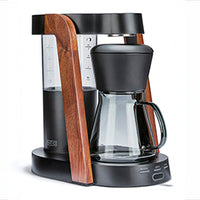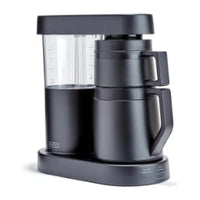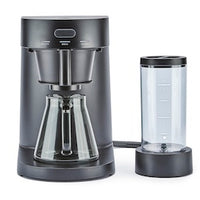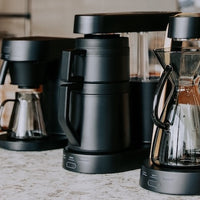Think Your Cold Brew Is Strong? It Might Just Be Over-Extracted
Key Takeaways
-
“Strong” coffee isn’t always a sign of quality — over-extraction can create harsh, bitter flavors
-
Cold brew is more prone to over-extraction because of its long steeping time
-
The wrong grind size, steep time, or coffee-to-water ratio can cause imbalance
-
Proper brewing should yield a smooth, naturally sweet, and complex cold brew
-
Small adjustments in method can turn a bitter batch into a balanced one
Cold brew has a reputation for being smooth, mellow, and easy to drink. But sometimes, a sip of “strong” cold brew delivers more bitterness than balance. If you’re confusing intensity with quality, you might be dealing with over-extraction.
Let’s break down what over-extraction means, why it happens so easily with cold brew, and how to avoid it.
What Over-Extraction Actually Means
When you brew coffee, water pulls out different compounds from the grounds:
-
First come the bright, fruity, and acidic notes
-
Then sweetness and body develop
-
Finally, bitter compounds emerge
Over-extraction happens when you pull too much from the grounds, letting bitterness overpower everything else. The result? A harsh, dry finish that lingers unpleasantly.
Cold brew’s long steeping time (often 12–24 hours) makes it easy to cross the line from sweet and full-bodied to flat and bitter.
Common Causes of Over-Extraction in Cold Brew
-
Grind Too Fine
Finer grounds release more surface area to water, which speeds up extraction. For cold brew, this often means bitterness builds long before you stop steeping. -
Steep Time Too Long
Even with coarse grinds, leaving your brew for 24+ hours can pull out harsher flavors. -
Too Much Coffee
A high coffee-to-water ratio can overwhelm the brew with concentrated, bitter compounds. -
Agitating Too Much
Stirring is good at the start, but excessive agitation during steeping can cause uneven extraction.
The Ideal Cold Brew Parameters
To avoid over-extraction while still getting a satisfying brew:
-
Grind: Coarse, similar to raw sugar
-
Ratio: About 1:4 to 1:8 coffee to water depending on strength preference
-
Steep Time: 12–18 hours in the fridge or at room temperature
-
Agitation: Stir once at the start to saturate grounds, then leave it alone
These adjustments give your cold brew time to develop sweetness and complexity without pulling too many bitter compounds.
Recognizing Over-Extraction by Taste
Your palate is the best tool for diagnosing issues:
-
Harsh, sharp bitterness that dominates other flavors
-
Dry, puckering sensation after swallowing
-
Lingering aftertaste without sweetness or clarity
Compare this to well-balanced cold brew, which should taste smooth, mildly sweet, and complex — even when strong.
How to Fix a Bitter Batch
If you’ve already made a too-bitter cold brew, all is not lost:
-
Dilute with cold water or milk to soften intensity
-
Add ice and let it melt before drinking
-
Use it for iced lattes where milk balances bitterness
-
Blend into recipes like coffee smoothies or baked goods
While these won’t remove bitterness entirely, they make the drink more palatable.
Why “Strong” Can Be Misleading
Many coffee drinkers equate a bold flavor with strength, but strength refers to the concentration of coffee in the cup, not the quality of extraction. A strong coffee can still be balanced; an over-extracted one is simply unbalanced.
Cold brew should be rich and flavorful without relying on bitterness for character.
Dialing in for Better Results
Consistency is key. Keep notes on your grind size, ratio, and steep time so you can make small changes and track improvements.
Cold brew rewards patience and precision just as much as hot coffee. By respecting the variables, you ensure every batch tastes intentionally strong — not accidentally bitter.
Brewing with the Right Equipment
Even if you roast your beans perfectly and grind them fresh, brewing mistakes can undo all that work. Coffee machines from Ratio Coffee are built to maintain ideal extraction parameters for hot brewing, but the same precision mindset applies to cold brew when you prepare it manually.
Getting the method right means you can enjoy a cold brew that’s strong in character — not in bitterness.
Frequently Asked Questions
Is bitterness always a sign of over-extraction?
Not always. Some beans naturally have bitter notes, but over-extraction exaggerates them and hides other flavors.
Can I make cold brew with medium grind coffee?
You can, but it’s more likely to over-extract. Stick to coarse for best results.
Should I stir cold brew during steeping?
Only at the start to ensure grounds are saturated, then let it sit undisturbed.
What’s the best water temperature for cold brew?
Room temperature or cold water works best; hot water changes extraction speed and flavor.
How do I make my cold brew less bitter?
Shorten steep time, use coarser grounds, and adjust coffee-to-water ratio.
 Ratio Eight S2
Ratio Eight S2
 Ratio Eight Original
Ratio Eight Original
 Ratio Six
Ratio Six
 Ratio Four
Ratio Four
 Compare Machines
Compare Machines






